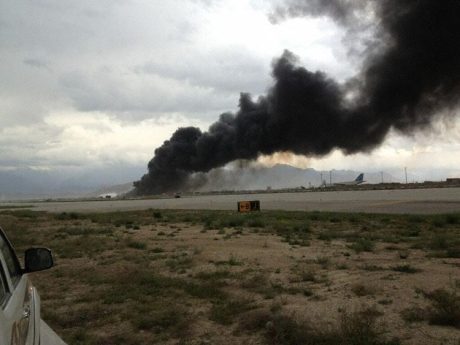
The test failed prematurely because of an unknown rocket anomaly.
A little less than one year after the first drop test, Virgin Orbit conducted a launch demonstration of the LauncherOne rocket on May 25, 2020. The test, performed over the Pacific Ocean off Los Angeles’ coast, was terminated prematurely because of an unspecified anomaly in the rocket’s first stage. This was the second launch attempt, after a first one was scrubbed the day before because of a minor sensor issue.
According to the press release, “The company successfully completed all of its pre-launch procedures, the captive carry flight out to the drop site, clean telemetry lock from multiple dishes, a smooth pass through the racetrack, terminal count, and a clean release. After being released from the carrier aircraft, the LauncherOne rocket successfully lighted its booster engine on cue — the first time the company had attempted an in-air ignition. An anomaly then occurred early in first stage flight, and the mission safely terminated. The carrier aircraft Cosmic Girl and all of its crew landed safely at Mojave Air and Space Port, concluding the mission.”
The specially modified Boeing 747-400 nicknamed “Cosmic Girl” took off from Mojave Air and Space Port at 11:56 A.M. local time (18:56 UTC) for the flight to the drop point. After a first “cold” pass through the racetrack at 30000 ft to check all the systems, the team flying aboard the B747 initiated the Terminal Count Autosequence and 15 minutes later, one minute before the scheduled drop, the aircraft performed a pull up maneuver at an angle of about 27.5 degrees up to 38000 ft and dropped the 70-foot-long (21 meters) rocket at 12:50 P.M. local time (19:50 UTC).

LauncherOne was expected to perform a Propellant Settling Thruster (PST) ignition three seconds after the drop followed two seconds later by the NewtonThree liquid-fueled rocket engine Main Engine Start (MES) and, about three minutes later, the Main Engine Cut Off (MECO). According to the available information, the anomaly happened during those three minutes of flight, as the company mentioned that the rocket was still using the first stage and we can see from the photo provided by Virgin Orbit that the engine fired successfully after the release.
For the sake of completeness, the NewtonThree is the first stage engine, generating about 75,000 lb (335 kN) of vacuum-equivalent thrust during the first phase of the launch, while the NewtonFour is the second stage engine, generating about 6,000 lb (26.5 kN) of vacuum-equivalent thrust during the orbital insertion of the payload.
In a phone interview to SpaceNews.com, Dan Hart, CEO of Virgin Orbit, said that the NewtonThree engine ignited successfully and the rocket flew for “a handful of seconds”, before the engine shut down, adding that the company is now investigating the anomaly. In the meanwhile, Virgin Orbit is in the final stages of the integration of the next rocket for a new attempt, and a half-dozen more rockets are already being manufactured.

The route flown by the Boeing 747-400 “Cosmic Girl” during the test. (Photo: FlightRadar24.com)
It is worth noting that LauncherOne was not carrying an operational payload, but rather carrying an inert mass to simulate the rocket behavior during an operational flight. The company is aiming to launch payloads up to about 1,100 lbs (500 kg) to Low Earth Orbit (LEO). As our own Tom Demerly wrote last year:
Branson’s Virgin Orbit LauncherOne may be a more practical approach to short lead-time, low cost orbital launches. LauncherOne is claimed to have a payload capacity of 300 kilograms (660 lbs.), although Space.com reports the payloads can be up to “1,100 lbs. (500 kilograms)”. Extremely short launch lead times can be only 24 hours from mission preparation to orbit, a feature that may make this launch technology attractive to military customers.
Branson’s greatest achievement with LauncherOne may be even more practical; cost. Boosting a payload into orbit using Virgin Orbit and LauncherOne may cost as little as $12M USD per mission. This compares to $62M USD to launch a larger 50,000 lb. payload into orbit using Elon Musk’s SpaceX Falcon 9 rocket. On a pound-per-dollar basis, SpaceX’s Falcon 9 is less expensive, but LauncherOne can specialize in smaller, shorter lead-time orbital payloads.
Finally, you may wonder why the Boeing 747 was chosen as launcher aircraft. The B747 is designed to carry an extra, non-operational, engine between the fuselage and the inner engine on the left wing. This feature is called “Fifth Pod” and was often used to transport spare engines where needed without using a charter flight. The only modification needed by Cosmic Girl was a custom pylon to carry the LauncherOne rocket.



